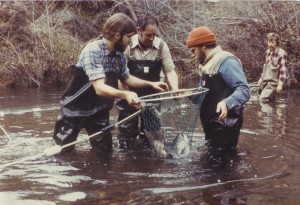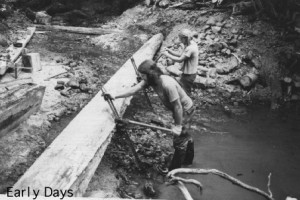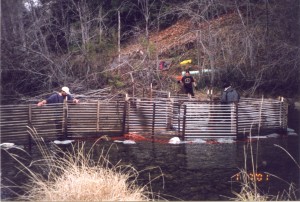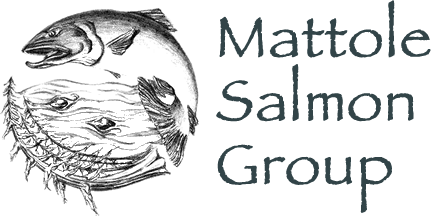History
MSG Project Timeline
1981 – Hatchbox Program: Mill Creek hatchbox established on Rathbun’s property and several thousand donated steelhead eggs hatched, reared, and released. Adult trap and holding box established at A.W. Way Park near Petrolia. Ferro-cement pond and hatchbox facility built near Arcanum Ranch in Mattole headwaters. First native Chinook eggs incubated and reared at Whale Gulch hatchbox.

Founding Fathers (Gary Peterson (left) and David Simpson (right) with Department of Fish and Game Representative (center) in the early days of the MSG Hatchbox Program. Freeman House in background.
1981 – Spawner surveys. Comprehensive spawner surveys and carcass counts begun, focusing on assessment of Chinook salmon runs. Thereafter, annual surveys have been maintained at greater or lesser intensity, depending on availability of funds.
1984 – Estuary research project begun on juvenile Chinook and steelhead, in cooperation with HSU graduate students, through 1991.
1985 – Downstream Migrant Trapping via fyke trap near Petrolia begun, continued through 1996 (in cooperation with HSU graduate students, through 1991).

MSG Large Woody Debris Project in the early days
1985 – Large Woody Debris initial project at Mill Creek to enhance coho spawning habitat:
1985 – Classroom Incubator Project initiated.
1986 – Alder planting along south secondary channel and the Dogleg Pool initiated and continued through 1988.
1989 – Willow planting initiated in estuary, continued in 1993 and 1994.
1989 – Floating structures for habitat improvement constructed in estuary.
1990 – Scouring structures installed along estuary banks.
1991 – Large Woody Debris project in Lower East Fork of Honeydew Creek.
1992 – Boulder scouring structure installed at Mill Creek confluence and 4 boulder weirs constructed in lower 50 yards of Mill Creek.
1994 – 2 scouring structures modified above Mill Creek confluence.
1994 – Large Woody Debris projects in the Mattole headwaters area initiated. Yew Creek modified with debris-jam barriers, log cribbing installation and bank-armor log placement.
1994 – Rescue Rearing Program started with the first diversion of downstream migrant Chinook into the Mill Creek pond.
1995 – Temperature Monitoring Program initiated.
1996 – Aquatic Benthic Macro invertebrate sampling initiated.
1996 – First annual dives to identify and count adult summer steelhead and juvenile salmonids initiated.
1996 – Downstream migrant trapping near Petrolia switches to rotary screw trap from fyke trap.
1996 – 8 Complex log structures installed in upper mainstem Mattole.
1996 – Installed 31 instream log and log/boulder cover structures for pool enhancement and 17 bank protection structures for erosion control in mainstem Mattole, upstream from the county bridge.
1997 – New wing dam constructed at Rathbun property.
1997 – Downstream Migrant Trapping via pipe trap on Bear Creek begins.
1998 – Road improvements, bank stabilization and instream enhancement at 32 priority sites in upper Thompson Creek (RM 58.4), continued through 1999. This was Phase 1 of the Upper Thompson Creek road rehabilitation project. Phase 2 was completed in summer of 2002.
1998 – Installed 17 instream log cover structures in the upper mainstem Mattole and lower Thompson Creek (RM 58.4).
1999 – Installed 11 instream log cover structures and augmented 2 existing complex structures, in the upper mainstem Mattole and Thompson Creek, completed in the summer of 2001.
1999 – V-star sediment monitoring initiated.
2000 – Installed 10 instream log cover structures in the upper mainstem Mattole, between Stanley Creek (RM 57.1) and the town of Whitethorn, through 2001.
2001 – Channel Monitoring begun in Middle Creek and Westlund Creek, expanded to include key tributaries in the upper Mattole in 2002. Mattole Salmon Group subcontracted as part of the Mattole Restoration Council Good Roads, Clear Creeks Program.

MSG Adult Trap at Ettersburg, 2001.
2001 – Downstream Migrant Trapping via pipe trap on the mainstem at Ettersburg begins.
2002 – Channel Monitoring in Mill Creek and Thompson Creek prior to completion of sediment-reduction treatments.
2002 – Green Fir Road Bank protection project completed.
2002 – Installed 10 log cover structures in lower and middle Thompson Creek. Project to completed in summer of 2003.
2002 – Road related sediment reduction work, bank stabilization, and instream enhancement at 26 priority sites in upper Thompson Creek, Phase 2.
2003 – Baseline Channel monitoring in 14 tributary reaches associated with sediment-reduction treatments.
2003 – Released 244 yearling Chinook in the fall and was approved for rescue rearing at MSG’s Mill Creek facility by CDFW.
2003 – A large complex boulder/rootwad structure was built in the Estuary.
2004 – Released 10,727 Chinook smolts in the spring anf 1,185 yearling Chinook in the fall, and was approved for rescue rearing at MSG’s Mill Creek facility by CDFW.
2004 – MSG monitored the streamflow of four different sites, streamflow marker 1 line, approximately 1000 ft downstream of one lane bridge after crossing Mendocino County line, streamflow marker 2 State Parks swimming hole immediately upstream of big pool at confluence with Stanley Creek, streamflow marker 3 Whitethorn Junction swimming hole just downstream of big pool confluence with McKee Creek, streamflow marker 4 Shelter Cove Bridge swimming hole- just upstream of the big pool below the bridge.
2004 – MSG constructed five willow baffles protruding from the north bank of the Mattole River Estuary.
2004 – MSG placed large boulder/rootwad structure in Estuary.
2004 – MSG planted 300 Alder and Cottonwood trees along lower Stansberry Creek.
